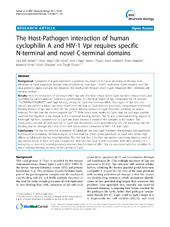| dc.contributor.author | Solbak, Sara Marie Øie | en_US |
| dc.contributor.author | Wray, Victor | en_US |
| dc.contributor.author | Horvli, Ole | en_US |
| dc.contributor.author | Raae, Arnt Johan | en_US |
| dc.contributor.author | Flydal, Marte Innselset | en_US |
| dc.contributor.author | Henklein, Petra | en_US |
| dc.contributor.author | Henklein, Peter | en_US |
| dc.contributor.author | Nimtz, Manfred | en_US |
| dc.contributor.author | Schubert, Ulrich | en_US |
| dc.contributor.author | Fossen, Torgils | en_US |
| dc.date.accessioned | 2014-11-07T15:00:34Z | |
| dc.date.available | 2014-11-07T15:00:34Z | |
| dc.date.issued | 2011-12-20 | eng |
| dc.identifier.issn | 1472-6807 | |
| dc.identifier.uri | https://hdl.handle.net/1956/8727 | |
| dc.description.abstract | Background: Cyclophilin A (CypA) represents a potential key molecule in future antiretroviral therapy since inhibition of CypA suppresses human immunodeficiency virus type 1 (HIV-1) replication. CypA interacts with the virus proteins Capsid (CA) and Vpr, however, the mechanism through which CypA influences HIV-1 infectivity still remains unclear. Results: Here the interaction of full-length HIV-1 Vpr with the host cellular factor CypA has been characterized and quantified by surface plasmon resonance spectroscopy. A C-terminal region of Vpr, comprising the 16 residues 75GCRHSRIGVTRQRRAR90, with high binding affinity for CypA has been identified. This region of Vpr does not contain any proline residues but binds much more strongly to CypA than the previously characterized N-terminal binding domain of Vpr, and is thus the first protein binding domain to CypA described involving no proline residues. The fact that the mutant peptide Vpr75-90 R80A binds more weakly to CypA than the wild-type peptide confirms that Arg-80 is a key residue in the C-terminal binding domain. The N- and C-terminal binding regions of full-length Vpr bind cooperatively to CypA and have allowed a model of the complex to be created. The dissociation constant of full-length Vpr to CypA was determined to be approximately 320 nM, indicating that the binding may be stronger than that of the well characterized interaction of HIV-1 CA with CypA. Conclusions: For the first time the interaction of full-length Vpr and CypA has been characterized and quantified. A non-proline-containing 16-residue region of C-terminal Vpr which binds specifically to CypA with similar high affinity as full-length Vpr has been identified. The fact that this is the first non-proline containing binding motif of any protein found to bind to CypA, changes the view on how CypA is able to interact with other proteins. It is interesting to note that several previously reported key functions of HIV-1 Vpr are associated with the identified Nand C-terminal binding domains of the protein to CypA. | en_US |
| dc.language.iso | eng | eng |
| dc.publisher | BioMed Central | eng |
| dc.rights | Attribution CC BY | eng |
| dc.rights.uri | http://creativecommons.org/licenses/by/2.0 | eng |
| dc.title | The Host-Pathogen interaction of Human Cyclophilin A and HIV-1 Vpr requires specific N-terminal and novel C-terminal domains | en_US |
| dc.type | Peer reviewed | |
| dc.type | Journal article | |
| dc.date.updated | 2013-08-23T09:33:09Z | |
| dc.description.version | publishedVersion | en_US |
| dc.rights.holder | Sara MØ Solbak et al.; licensee BioMed Central Ltd. | |
| dc.rights.holder | Copyright 2011 Solbak et al; licensee BioMed Central Ltd | |
| dc.source.articlenumber | 49 | |
| dc.identifier.doi | https://doi.org/10.1186/1472-6807-11-49 | |
| dc.identifier.cristin | 909035 | |
| dc.source.journal | BMC Structural Biology | |
| dc.source.40 | 11 | |

